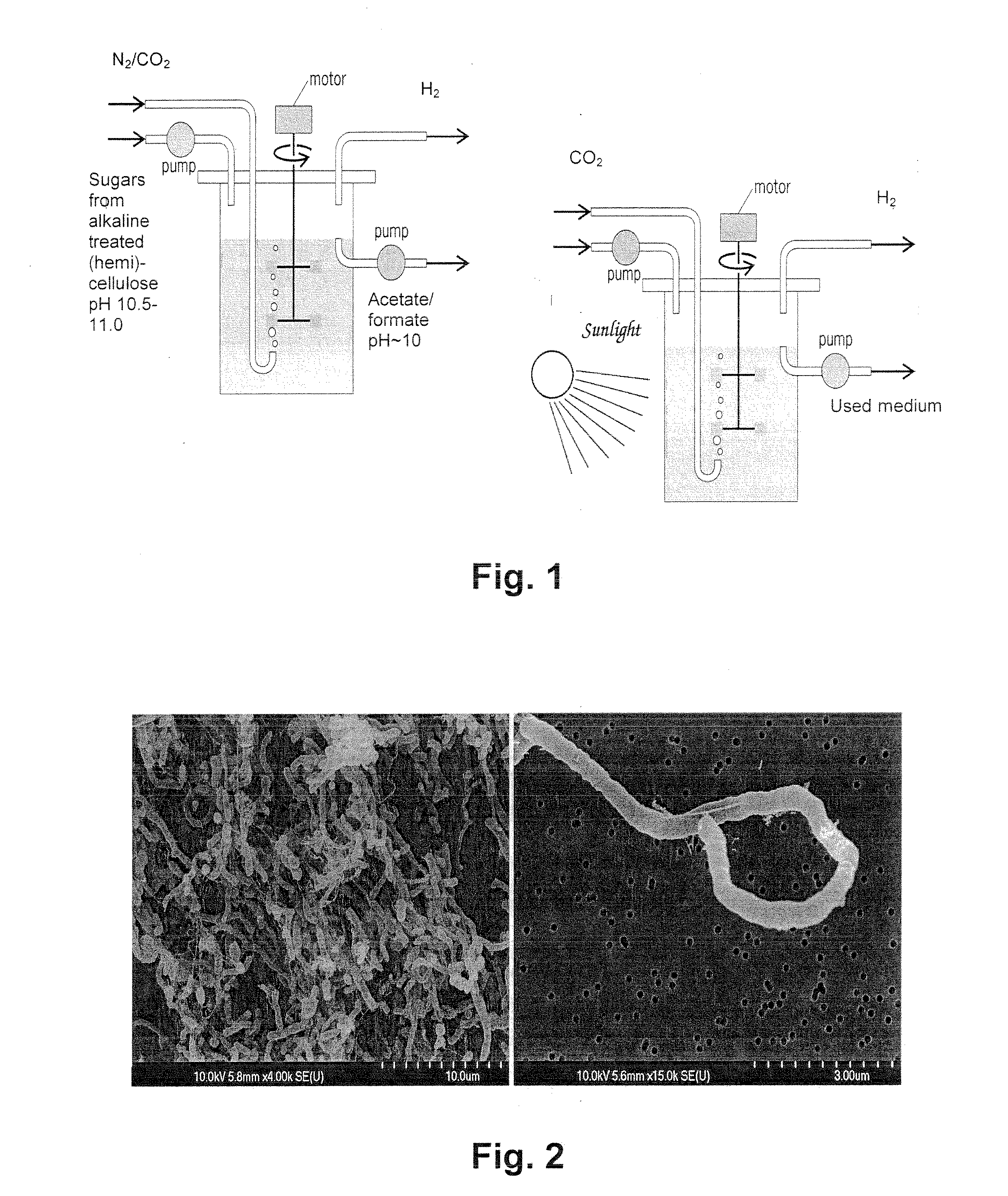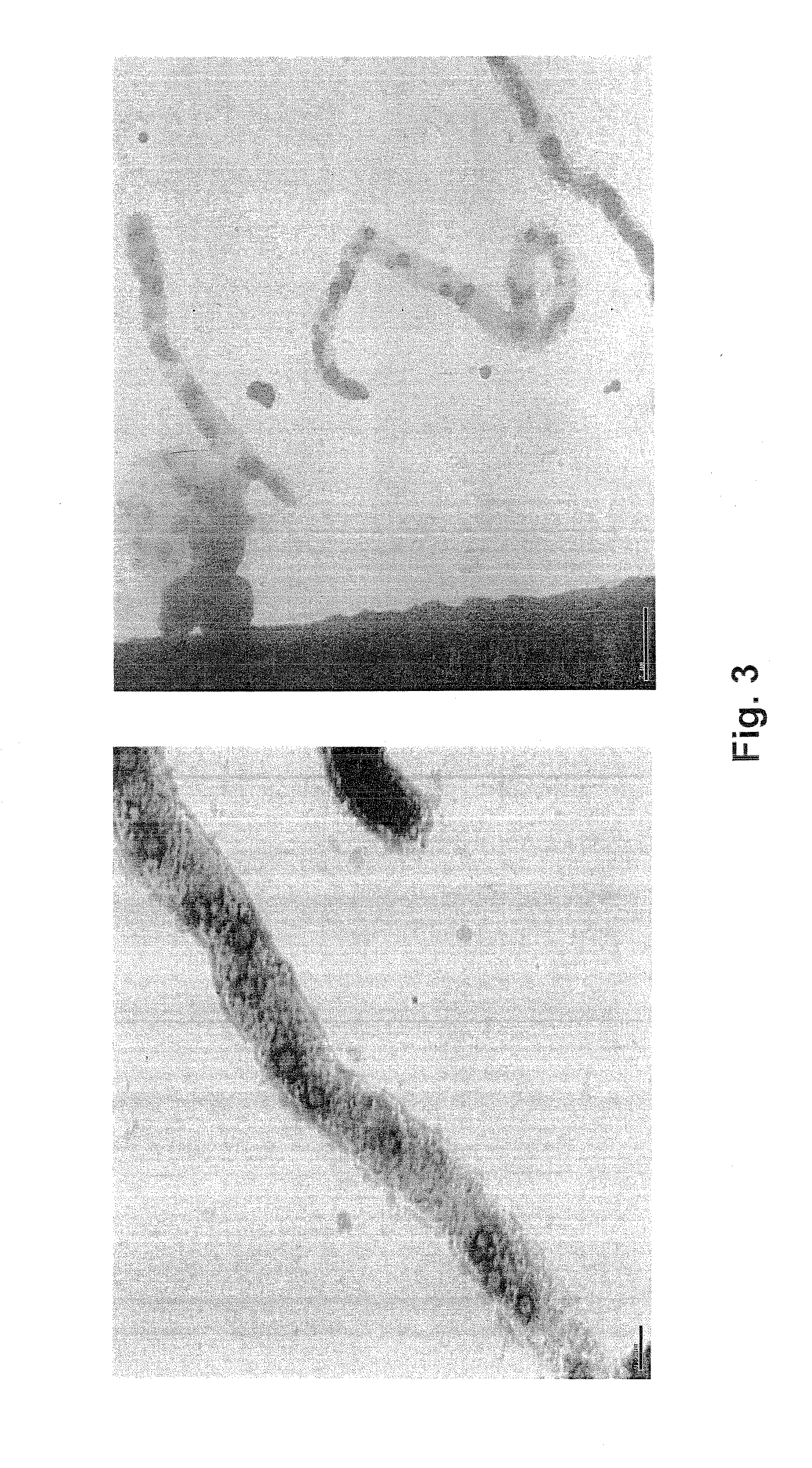Fossil fuel-free process of lignocellulosic pretreatment with biological hydrogen production
- Summary
- Abstract
- Description
- Claims
- Application Information
AI Technical Summary
Benefits of technology
Problems solved by technology
Method used
Image
Examples
example 1
Isolation of Microorganism
[0043]The microorganism was found in the United States. The sampling site had a natural pH value of 10, a salt content ranging from 15-140 g NaCl / L of sample, and a high sulfide concentration ranging between 4.3-10.5 g / L. All plates and colony manipulations were carried out in a Coy anaerobic chamber (Coy Laboratory Products Inc., Grass Lake, Mich.) under an atmosphere of approximately 95% N2 / 5% H2.
[0044]Sediment samples were enriched using a culturing medium with glucose or cellobiose as the electron donor source. Serial dilution plating on medium containing 1.25% (wt. / vol.) agar was then used to isolate single colonies and attain a pure culture.
[0045]Medium for enrichment included (per liter): 120 g NaCl, 1.12 g Na2B4O7, 1.0 g NH4Cl, 0.06 g CaCl2.2H2O, 0.05 g MgCl2.6H2O, 0.05 g FeCl2.6H2O, 0.79 g C3H5O3Na, 0.58 g C2H3O2Na, 0.85 g NaNO3, 0.01 g KCl, 0.5 g tryptic soy broth, 0.5 g α-ketoglutaric acid, and 0.5 g disodium salt, along with 10 ml trace mineral ...
example 2
Preparation of Culture Tubes with Sugar Substrates
[0055]Cultures were grown under anaerobic conditions in 28 ml Balch / Hungate tubes with a liquid volume of 5 ml capped with blue butyl rubber stoppers, crimp sealed with aluminum seals, and gassed with 80% N2 / 20% CO2. All medium components and sugars were purchased from either Sigma Life Science (St. Louis, Mo.) or Fisher Scientific (Pittsburgh, Pa.).
[0056]The empty tubes were first degassed, autoclaved at 121° C. for 20 minutes, and cooled to room temperature. Once cool, the culture medium described in Example 1 was added via filter sterilization using 0.2 μm syringe filters.
[0057]Stock solutions containing the carbon sources (sugars) were then filter-sterilized into the sterile culture tubes through 0.2 μm pore size syringe filters. The stock solutions of the carbon sources were prepared separately for each carbon source: cellobiose, glucose, mannose, ribose, galactose, arabinose, and xylose. The stock solutions were all used at a f...
example 3
[0059]In this Example, the growth and metabolic by-products of the sugar cultures prepared in Example 2 were measured under non-agitating conditions at 30° C., and pH 11, with 7% (v / v) NaCl. Growth was followed by optical density as well as by protein quantification. Protein concentration was determined using a modified Bradford assay. Hydrogen molar yield (HMY) was then calculated. For all tests, the time-dependent H2 generation was quantified on a Gas Chromatogram (Varian Inc., Palo Alto, Calif.; Model CP-3380) equipped with a Varian fused Silica Select Permanent Gas / CO2 HR column (CP-7430), operating at 30° C., and a thermal conductivity detector at 175° C. The carrier gas was N2 at 14 psi, and samples were analyzed using a Star Chromatography Workstation Version 5.50 software (Varian, Inc.). Injection volumes were 50 μl with the injection port temperature at 50° C.
[0060]The loss of the carbon source and appearance of organic acids was followed over time with High...
PUM
 Login to View More
Login to View More Abstract
Description
Claims
Application Information
 Login to View More
Login to View More - R&D
- Intellectual Property
- Life Sciences
- Materials
- Tech Scout
- Unparalleled Data Quality
- Higher Quality Content
- 60% Fewer Hallucinations
Browse by: Latest US Patents, China's latest patents, Technical Efficacy Thesaurus, Application Domain, Technology Topic, Popular Technical Reports.
© 2025 PatSnap. All rights reserved.Legal|Privacy policy|Modern Slavery Act Transparency Statement|Sitemap|About US| Contact US: help@patsnap.com



